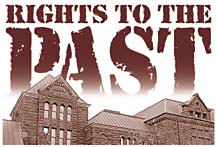
Museum votes
against ‘native’ status
The Bishop board bows to
concerns over potential conflicts
Bishop Museum's board of directors bowed to political pressure yesterday and voted unanimously against a proposal to be designated as a native Hawaiian organization under federal laws governing the repatriation of artifacts from museums.
Museum Director Bill Brown said after the vote, "The museum acknowledges concerns over potential conflict in (being a claimant and) judging claims on objects in its collection, and has determined not to recognize itself" as a native Hawaiian organization.
 Although the board relented on the designation, it stood firm on other provisions included in its "guidance policy" that would allow the museum to fight to retain items in its collection that might be claimed by other native Hawaiian organizations. The board has never sought to retain human remains.
Although the board relented on the designation, it stood firm on other provisions included in its "guidance policy" that would allow the museum to fight to retain items in its collection that might be claimed by other native Hawaiian organizations. The board has never sought to retain human remains.
Isabella Abbott, one of the seven native Hawaiians on the museum's nine-member collection committee, said the museum will "bend over backwards" to repatriate items under the 1990 Native American Graves Protection and Repatriation Act.
However, Abbott said that when it comes to items not covered by NAGPRA's definitions, "we will defend those to the death."
NAGPRA was written as human rights policy aimed at righting the wrongs of the past and providing a procedure for American Indians and native Hawaiians to reclaim human remains and other funerary or sacred objects from museum display cases.
On June 30 the museum trigged an emotional debate among some native Hawaiians when it announced its "interim guidance policy," in which it proposed proclaiming itself a native Hawaiian organization under NAGPRA. Some native Hawaiians called for Brown's resignation.
U.S. Sen. Daniel Inouye, who wrote NAGPRA and serves as vice chairman of the Senate Committee on Indian Affairs, also opposed the museum's proposed policy.
Inouye's committee is expected to travel to Hawaii in November to hold hearings on the museum's proposal with the aim of clarifying or even rewriting NAGPRA.
The museum wanted the designation so that it could be on an equal footing with about 130 other native Hawaiian organizations in claiming items in its own collection.
Under NAGPRA there is a hierarchy that gives priority to claimants who can prove family ties to a particular item when resolving a dispute among competing claimants. After lineal ties, there are various levels of cultural ties. The museum has said it would have to submit to the same criteria in a competing claim.
But critics argue that designating a museum a native Hawaiian organization defeats the intent of NAGPRA. They also said it posed a severe conflict of interest because the museum would be both claimant and the arbiter of who would win possession of an item.
"The interim guidance policy was a gross waste of everyone's time," said Eddie Halealoha Ayau, a critic of the museum's policy and spokesman for Hui Malama I Na Kupuna O Hawaii Nei, a native Hawaiian organization founded in 1989 in part to repatriate ancestral remains and other sacred objects.
"The museum should have discussed the matter with the community first and then developed its policy. Instead, it promulgated the policy first and then acknowledged there was a conflict of interest," he said.
La'akea Suganuma of the Royal Hawaiian Academy of Traditional Arts, which has challenged Hui Malama as a claimant in the past, said: "The museum's reluctance to pursue native Hawaiian status is understood. But I don't think it precludes them from doing everything possible to protect its collection."
The debate comes as federal investigators and the state attorney general's office are conducting parallel investigations into the alleged black-market trafficking of items repatriated to native Hawaiian organizations from Bishop Museum and the Peabody Essex Museum.
The museum's policy also seeks to clarify its ownership or "right of possession" of various items on a case-by-case basis. The museum has retained outside counsel to determine whether it owns specific items under state law. If ownership of an item is proved under state law, then the museum will claim it has "right of possession" under NAGPRA.
"Why are they talking about state law? It's cute and interesting, but repatriation is governed by federal law," said Ayau.
Ayau and others contend that many items in the collection were stolen from graves and then sold or donated to the museum and therefore do not rightfully belong to the museum.
Another area of contention covered in the proposal is "sacred objects," which NAGPRA defines as objects necessary for the practice of native Hawaiian religion. The museum contends it does not have such objects in its collection, based on its understanding that items for rituals can be newly made.
Richard Paglinawan, another native Hawaiian on the museum collection committee, cited a sacred staff with a bald Lono. In reviving an ancient ritual, he said his group studied the staff and was able to create its own staff and that other groups have created their own.
"We don't need the original in our practice, but we do need access to the original to study and make our own," said Paglinawan. "The original is a one-of-a-kind. I want my grandson and future generations to be able to come back and see it. It should not be owned by just one" religious group.
www.bishopmuseum.org